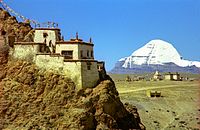
In structural geology, a roof pendant, also known as a pendant, is a mass of country rock that projects downward into and is entirely surrounded by an igneous intrusion such as a batholith or other pluton. In lay terminology sometimes "rock hat" is used. A roof pendant is an erosional remnant that was created by the removal of the overlying country rock that formed the roof of the igneous intrusion that encloses it. If this downward protruding mass of roof rock still has a connection to the main, surrounding mass of country rock, they are known by structural geologists as either septa or screens.[1][2][3] Roof pendants typically have been strongly metamorphosed through the processes of contact metamorphism.[4]
A classic, well-documented example of a roof pendant is the strata that comprise Mount Morrison within the Sierra Nevada in Mono and Fresno counties, California. It lies midway between Mono Lake on the north and Bishop, California, on the south. Mount Morrison consists of a roof pendant that underlies an area of 62 km2 (24 sq mi). This roof pendant consists of a 15,000 m- (50,000 ft-) thick sequence of complexly folded and faulted metasedimentary strata and metavolcanic strata. The eastern two-thirds of this roof pendant consists of Cambrian to Silurian and Pennsylvanian to Permian metasedimentary strata. Metavolcanic rocks of Mesozoic age comprise the western third of the roof pendant. Mesozoic granitic rocks enclose and intrude the pendant rocks. These granitic rocks consist predominantly of quartz monzonite and granodiorite with local, minor, scattered bodies of granite, aplite, diorite and gabbro. These pendants are part of a discontinuous, 140 kilometres (87 mi)-long, northwest-trending belt of roof pendants that are preserved within the granitic plutons of Sierra Nevada.[5][6][7][8]
- ^ U.S. Bureau of Mines Staff (1996) Dictionary of Mining, Mineral, & Related Terms. Report SP-96-1, U.S. Department of Interior, U.S. Bureau of Mines, Washington, D.C.
- ^ Neuendorf, KKE, JP Mehl, Jr., and JA Jackson, eds. (2005) Glossary of Geology (5th ed.). Alexandria, Virginia, American Geological Institute. 779 pp. ISBN 0-922152-76-4
- ^ Best, MG (2003) Igneous and metamorphic petrology, 2nd ed. Blackwell Science Ltd., New York, New York. 729 pp. ISBN 1-40510-588-7
- ^ Bucher, K, and R Grapes (2011) Petrogenesis of Metamorphic Rocks. Springer, New York, New York. 428 pp. ISBN 978-3-540-74168-8
- ^ Greene, DC, and CH Stevens (1999) Stratigraphy, depositional history, and tectonic evolution of Paleozoic continental-margin rocks in roof pendants of the eastern Sierra Nevada, California. Geological Society of America Bulletin. 111(6):919-933.
- ^ Greene, DC, and CH Stevens (2002) Geologic Map of Paleozoic Rocks in the Mount Morrison Pendant, Eastern Sierra Nevada. California Map Sheet no 53. California Division of Mines and Geology, Sacramento, California.
- ^ Rinehart, CD, and DC Ross (1964) Geology and mineral deposits of the Mount Morrison quadrangle, Sierra Nevada, California. Professional Paper no. 385. United States Geological Survey, Reston, Virginia. 106 pp.
- ^ Russell, S, and W Nokleberg (1977) Superimposition and timing of deformations in the Mount Morrison roof pendant and in the central sierra Nevada, California. Geological Society of America Bulletin. 88(3):335-345.